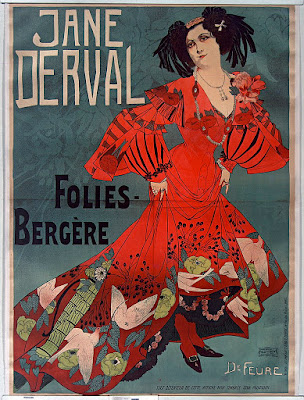 |
| Georges de Feure Fonty - Concert Européen - Tous les Soirs 1890 lithograph (poster) Bibliothèque Nationale, Paris |
 |
| Georges de Feure La Dépêche 1902 lithograph (poster) Bibliothèque Nationale, Paris |
 |
| Georges de Feure Salon des Cent 1895 lithograph (poster) Bibliothèque Nationale, Paris |
 |
| Georges de Feure Jane Derval - Folies Bergère 1904 lithograph (poster) Bibliothèque Nationale, Paris |
 |
| Georges de Feure La Loїe Fuller dans sa création nouvelle, Salomé 1895 lithograph (poster) Bibliothèque Nationale, Paris |
 |
| Georges de Feure Marjolaine 1896 lithograph (poster) Bibliothèque Nationale, Paris |
 |
| Georges de Feure Paris-Almanach 1894 lithograph (poster) Bibliothèque Nationale, Paris |
 |
| Georges de Feure L'Horloge 1894 lithograph (poster) Bibliothèque Nationale, Paris |
 |
| Georges de Feure Edmée Lescot - Casino de Paris 1890 lithograph (poster) Bibliothèque Nationale, Paris |
 |
| Georges de Feure Le Meilleur des Thés Société des Palais Indiens 1896 lithograph (poster) Bibliothèque Nationale, Paris |
 |
| Georges de Feure La Source du Mal 1894 lithograph Metropolitan Museum of Art, New York |
 |
| Georges de Feure Design for Hallway with Wrought-Iron Details ca. 1925 watercolor Metropolitan Museum of Art, New York |
 |
| Georges de Feure Designs for Wardrobe, Chair, Bureau and Washstand ca. 1925 watercolor Metropolitan Museum of Art, New York |
 |
| Georges de Feure Fashion Illustration 1903 watercolor private collection |
 |
| Georges de Feure Le Cirque Corvi ca. 1893 gouache and watercolor Clark Art Institute, Williamstown, Massachusetts |
"Georges Joseph Van Sluyters, better known as Georges de Feure, was born in Paris in 1868 into a Belgian and Dutch family. In 1870, during the Franco-Prussian war, the family moved to Amsterdam. In 1886 De Feure was accepted at the Royal Academy of Fine Arts in Amsterdam, but left in dissatisfaction after a short time and returned to Paris. In 1890 he settled in Montmartre and became a student of Jules Chéret. During the next decade De Feure produced a stream of popular lithographic posters, while also painting independently and illustrating books. In 1903 he mounted retrospective exhibitions in Paris and several other European cities. After 1910 he began to design sets and costumes for theater productions, as well as jewelry, ceramics, and interiors. Yet by the time the Great Depression hit, the artist's style had fallen out of fashion, and he descended into poverty, dying in 1943 during the Paris Occupation."
– from biographical notes published by Galerie des Modernes, Paris